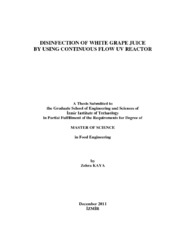Please use this identifier to cite or link to this item:
https://hdl.handle.net/11147/3184Full metadata record
| DC Field | Value | Language |
|---|---|---|
| dc.contributor.advisor | Ünlütürk, Sevcan | en |
| dc.contributor.author | Kaya, Zehra | - |
| dc.date.accessioned | 2014-07-22T13:51:02Z | - |
| dc.date.available | 2014-07-22T13:51:02Z | - |
| dc.date.issued | 2011 | en |
| dc.identifier.uri | http://hdl.handle.net/11147/3184 | - |
| dc.description | Thesis (Master)--Izmir Institute of Technology, Food Engineering, Izmir, 2011 | en |
| dc.description | Includes bibliographical references (leaves: 105-113) | en |
| dc.description | Text in English; Abstract: Turkish and English | en |
| dc.description | xvi, 122 leaves | en |
| dc.description | Full text release delayed at author's request until 2015.01.11 | en |
| dc.description.abstract | Although continuous flow UV irradiation process is applied to several kind of fruit juices as a non-thermal method, it hasnot treated to white grape juice before. The main objective was to study the effect of commercial UV disinfection system on the spoilage microorganisms in white grape juice. Physical, chemical and optical properties were measured after and before irradiation. Biodosimetric studies were performed by using Bench Top UV apparatus and continuous flow commercial UV reactor. Bench top UV study showed that 228.96 mJ/cm2 UV dose provided complete inactivation of S. cerevisiae in the pasteurized juice at 0.91 mW/cm2 UV intensity.. 3.00±0.16 log cfu/ml yeasts and 4.32±0.03 log cfu/ml lactic acid bacteria reduction were detected in naturally fermented juice after 282.24 mJ/cm2 UV dose. D(10) of yeasts (43.86 mJ/cm2) were higher than lactic acid bacteria (33.78 mJ/cm2) because of showing higher resistance to UV light. In the continuous flow UV reactor, the highest reduction of S. cerevisiae was achieved as 3.39±0.044 log cfu/ml at 56.06 mJ/cm2 UV dose and low flow rate (820 ml/min) in pasteurized juice. However, highest reduction was observed in yeast and lactic acid bacteria count as 1.70±0.028 log cfu/ml and 2.49±0.0031 log cfu/ml respectively at 19.96 mJ/cm2 UV dose in medium flow rate (1516 ml/min) of fresh squeezed juice. Absorbance, color, and titratable acidity were changed by irradiation. As a result of 13 days shelf life study, no significant increase was seen in spoilage microorganisms after irradiation. | en |
| dc.language.iso | en | en_US |
| dc.publisher | Izmir Institute of Technology | en_US |
| dc.rights | info:eu-repo/semantics/embargoedAccess | en_US |
| dc.subject.lcsh | Ultraviolet radiation | en |
| dc.subject.lcsh | Disinfection and disinfectants | en |
| dc.subject.lcsh | Food spoilage | en |
| dc.subject.lcsh | Food--Microbiology | en |
| dc.subject.lcsh | Fruit juices | en |
| dc.subject.lcsh | Fruit juice--Pasteurization | en |
| dc.subject.lcsh | Fruit juice industry | en |
| dc.title | Disinfection of white grape juice by using continuous flow uv reactor | en_US |
| dc.type | Master Thesis | en_US |
| dc.institutionauthor | Kaya, Zehra | - |
| dc.department | Thesis (Master)--İzmir Institute of Technology, Food Engineering | en_US |
| dc.relation.publicationcategory | Tez | en_US |
| item.languageiso639-1 | en | - |
| item.fulltext | With Fulltext | - |
| item.openairecristype | http://purl.org/coar/resource_type/c_18cf | - |
| item.openairetype | Master Thesis | - |
| item.grantfulltext | open | - |
| item.cerifentitytype | Publications | - |
| Appears in Collections: | Master Degree / Yüksek Lisans Tezleri | |
Files in This Item:
| File | Description | Size | Format | |
|---|---|---|---|---|
| 421172.pdf | MasterThesis | 2.38 MB | Adobe PDF |  View/Open |
CORE Recommender
Page view(s)
142
checked on Jul 22, 2024
Download(s)
130
checked on Jul 22, 2024
Google ScholarTM
Check
Items in GCRIS Repository are protected by copyright, with all rights reserved, unless otherwise indicated.